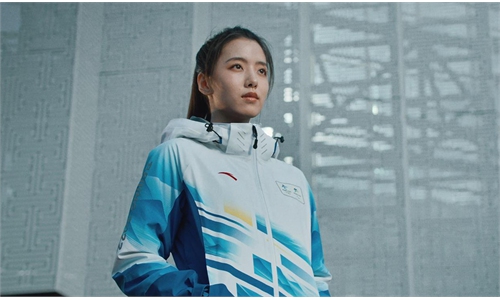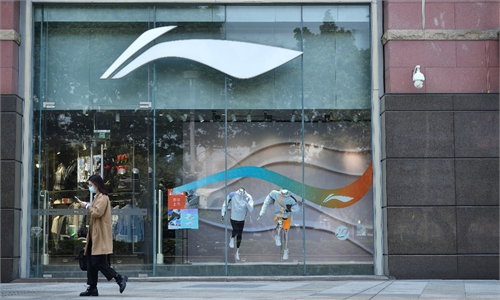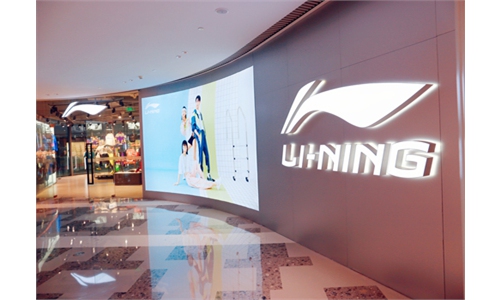Chinese sportswear brands see rosy profits as consumers shift to local products amid Western Xinjiang cotton ‘boycott’
Consumers shift to local products amid Western slander, tech rise
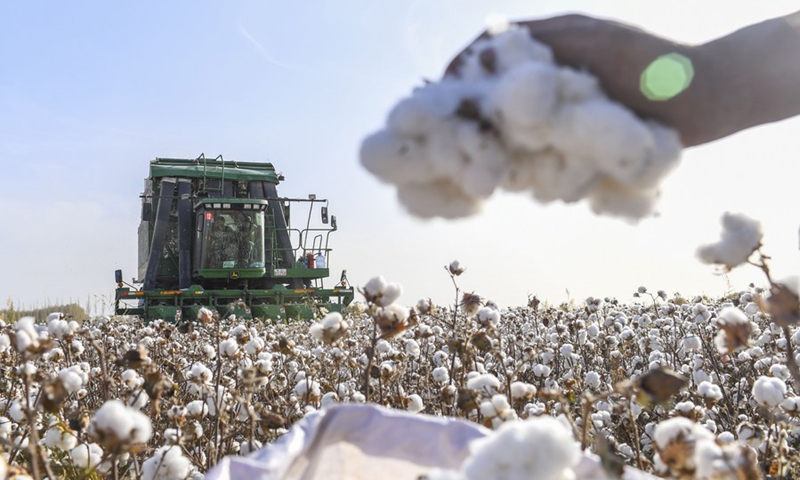
A cotton picking machine moves in a cotton field in Dolatbag Town of Bachu County, northwest China's Xinjiang Uygur Autonomous Region. File photo: Xinhua
A variety of Chinese sportswear brands have reported a rosy profit last year, with some recording three-digit growth, as patriotic Chinese consumers "vote with their feet" to voice support for Xinjiang cotton amid Western relentless slander and crackdown, and as the just-concluded Beijing Olympics - a showcase of homegrown sports firms' tech prowess - further fueled a turnaround from overseas to brands at home.
Such explosive growth also fueled confidence in the cotton industries in Northwest China's Xinjiang Uygur Autonomous Region this year, where spring plowing season is falling and textile traders are anticipating another harvest year driven by a moderate rise in domestic demand, despite geopolitical uncertainties and the coronavirus outbreak.
Chinese sports and fashion brand Li Ning, a user of Xinjiang cotton, reported its financial earnings on Friday, with a 56 percent increase in year-over-year revenue to 22.57 billion yuan ($3.54 billion) in 2021. Profits rose 136 percent to 4.01 billion yuan, according to the company's financial report.
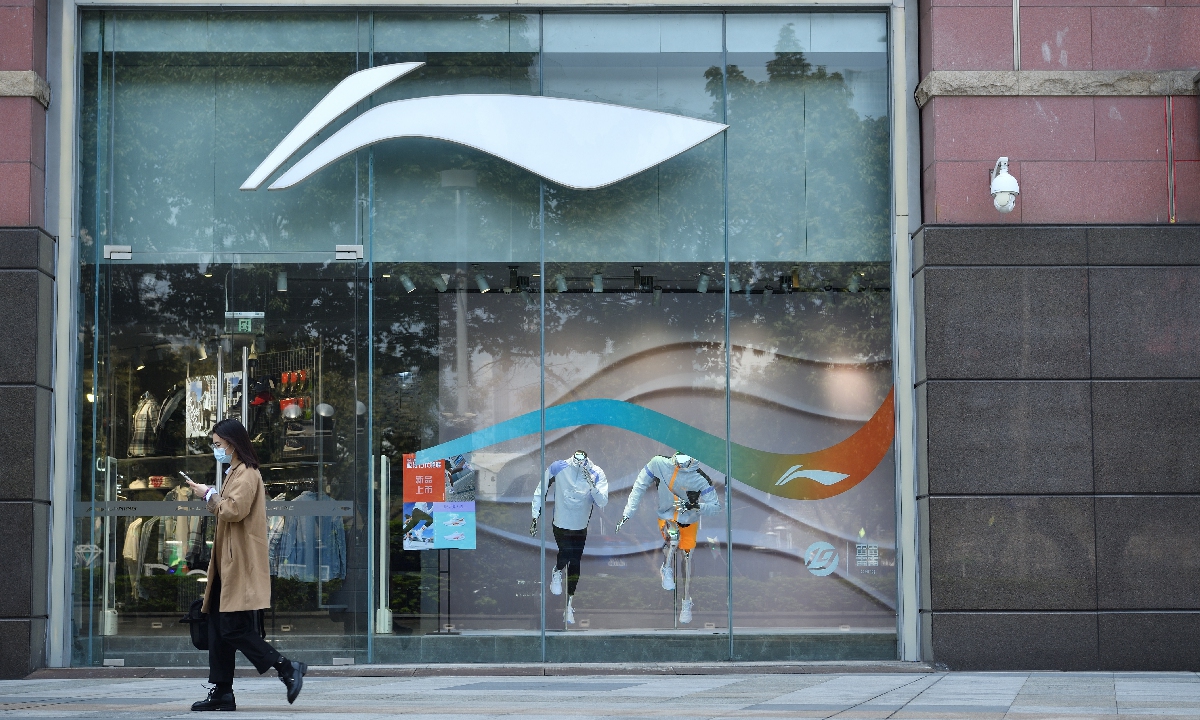
Li Ning Photo:VCG
Li Ning was among a dozen Chinese companies including Anta, Meters Bonwe and Semir which showed their support to Xinjiang cotton last March, after some Western brands, including Adidas, Nike and H&M, boycotted Xinjiang cotton for claimed forced labor, which sparked a fierce backlash in China.
Chinese sports brand Xtep also recorded a revenue of 10 billion yuan in 2021, with a year-on-year growth of 22.5 percent, a new high in the past five years, according to its financial results released on Wednesday. Profits also increased 77.1 percent year-on-year in 2021 to 908 million yuan.
Anta has yet to reveal its financial earnings for fiscal 2021. But the company's first-half revenue increased 55 percent compared with the same period in 2020. In July 2021, Anta surpassed Adidas as the world's second largest sports brand by market value.
Market watchers said that the good financial results of Li Ning and other Chinese brands showed the rise of domestic sportswear brands across the board last year, driven by design advantages in addition to patriotic sentiment. They expect the shining performance of domestic brands like Anta at the just closed Beijing Winter Olympic Games to bring further booming sales.
The shining performance of homegrown brands dwarfs the shrinking sales of Western sports brands in the Chinese market, which used to flourish. But they are "paying the price" for their mistakes in colluding with anti-China forces.
Adidas said its fourth-quarter revenue ending December 31 for the region including the Chinese mainland, Hong Kong Special Administrative Region and the island of Taiwan, fell 24 percent year-on-year due to the challenging market environment, according to the financial report released on March 9.
Nike's quarterly revenue in Greater China ending November 30, 2021 was $1.84 billion, down 20 percent year-on-year, according to a financial report on its website.
The Western governments' recent vilification against Chinese brands is further turning away Chinese consumers.
On Thursday, Li Ning pushed back against what it calls "incorrect and misleading allegations" by Washington against the company, after US authorities decided to detain Li Ning's sporting goods, claiming that the firm "uses North Korean labor in its supply chain."
While the patriotic sentiment fueled the shift, the rise of domestic sportswear brands is underpinned by the improvement in technology and design, analysts stressed.
As the official sportswear provider of the Beijing 2022 Winter Olympics, Anta has used its smart technology to equip 12 national teams in events including short track speed-skating, skeleton and curling.
Among them, the clothing for athletes' uniforms from Chinese short track speed skating team reached the global top levels for lightness and ventilation. The clothing material is 15 times stronger than steel wire and 30 percent lighter than nylon and polyester.
"The showrooms of Li Ning and Anta are more fashionable than years ago and their prices are also much higher. But the sales have proven Chinese customers are willing to pay for more fashionable domestic designs," Liu Dingding, a veteran industry observer, told the Global Times on Friday.
The growing demand for domestic sportswear brands will not be short-lived and is expected to last through the post Winter Olympics area, Liu said, noting that this will be a driving factor for the domestic cotton industry, among which Xinjiang is the country's largest cotton production base with 85 percent share of national output.
A manager of a textile company in Xinjiang surnamed Zhang told the Global Times on Friday that against the backdrop, he expects domestic demand for Xinjiang cotton to edge up "mildly" this year, despite disruptions from global geopolitical uncertainties and the resurgence of coronavirus cases in a number of Chinese manufacture bases.
The beginning of the year has been difficult, but the sales boom of domestic sportswear brands is funneling confidence in the textile industry," Zhang added.
According to Zhang, the spring plowing of cotton has been carried out as planned in Xinjiang. "It is in a stage of irrigation, after which local farmers will start planting," he explained.
